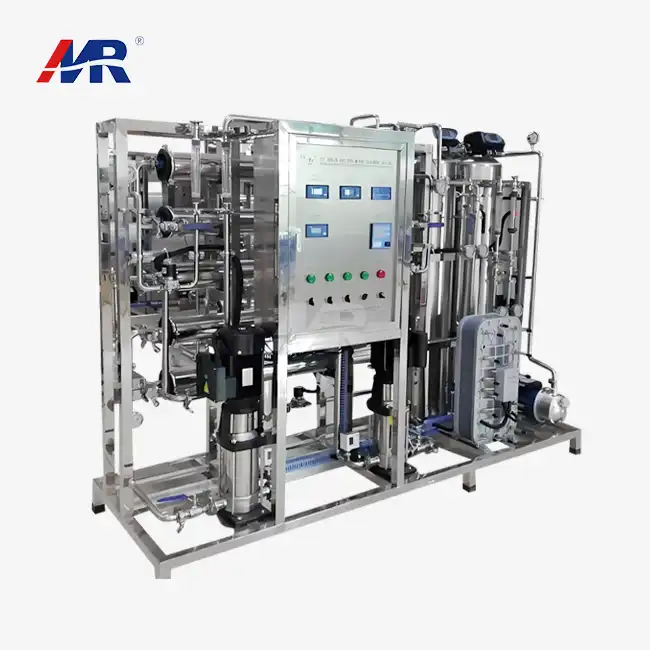Inside an EDI Module: Components Explained
To truly appreciate the sophistication of an EDI system, it's essential to understand its key components. At its core, an EDI module consists of several intricate parts working in harmony:
Ion Exchange Membranes
The foundation of an EDI module lies in its ion exchange membranes. These semi-permeable barriers are strategically arranged to create separate compartments within the module. Cation exchange membranes allow positively charged ions to pass through, while anion exchange membranes permit the passage of negatively charged ions. This selective permeability is crucial for the efficient removal of ions from the water stream.
Electrodes
Positioned at either end of the EDI module, electrodes generate the electric field necessary for ion migration. The cathode, typically made of stainless steel, attracts positively charged ions, while the anode, often constructed from titanium coated with platinum, draws negatively charged ions. This electrical gradient is the driving force behind the continuous deionization process.
Ion Exchange Resins
Filling the spaces between the membranes are beds of ion exchange resins. These tiny beads play a vital role in capturing and exchanging ions from the water. As water flows through the resin bed, ions are attracted to and held by the resin particles. The electric field then facilitates the movement of these captured ions towards their respective electrodes, maintaining the resin's ion exchange capacity without the need for chemical regeneration.
Spacers and Gaskets
Often overlooked but crucial for the module's integrity, spacers and gaskets ensure proper water flow and prevent leakage between compartments. These components maintain the structural integrity of the EDI module and optimize its performance by ensuring uniform water distribution across the ion exchange membranes and resin beds.
Understanding these components provides insight into the sophisticated engineering behind EDI technology. The synergy between these elements results in a continuous, efficient process that produces ultra-pure water with minimal energy consumption and environmental impact.
Customizing EDI Modules for Specific Industries
The versatility of EDI modules allows for customization to meet the unique requirements of various industries. This adaptability has made EDI technology indispensable across a wide range of applications:
Pharmaceutical and Biotechnology
In the pharmaceutical industry, water purity is paramount. EDI modules are customized to produce water that meets or exceeds pharmacopeia standards. These modules often feature enhanced sanitization capabilities and are designed to operate in conjunction with other purification technologies to achieve the highest levels of water purity for drug manufacturing and research applications.
Microelectronics and Semiconductor Manufacturing
The production of semiconductors and microelectronics demands water of exceptional purity to prevent contamination that could compromise product quality. EDI modules for this industry are engineered to achieve resistivity levels exceeding 18 MΩ·cm, often incorporating additional polishing stages to remove trace contaminants that could interfere with delicate manufacturing processes.
Power Generation
Power plants require large volumes of high-purity water for boiler feed and cooling systems. EDI modules designed for this sector focus on high flow rates and efficient removal of silica and other scale-forming ions. These modules are built to withstand continuous operation and often feature robust materials to cope with the demanding conditions of power generation facilities.
Food and Beverage Production
The food and beverage industry relies on pure water for product quality and safety. EDI modules for this sector are customized to remove specific ions that could affect taste or product stability. They often incorporate features that ensure compliance with food safety regulations and are designed for easy cleaning and sanitization.
Customization extends beyond these industries, with EDI modules being tailored for applications in chemical processing, laboratory research, and even specialized medical treatments. The ability to fine-tune EDI technology to specific needs underscores its versatility and importance in modern water purification.
Maintenance and Lifespan of EDI Modules
The longevity and performance of EDI modules depend significantly on proper maintenance and operational practices. Understanding the factors that influence the lifespan of these crucial components is essential for maximizing their efficiency and cost-effectiveness:
Preventative Maintenance Strategies
Regular maintenance is key to ensuring the optimal performance of EDI modules. This includes:
- Periodic inspection of membranes and electrodes for signs of wear or fouling
- Monitoring of key performance indicators such as product water quality and pressure drop across the module
- Regular cleaning procedures to remove any accumulated scale or organic matter
- Calibration of monitoring instruments to ensure accurate readings
Implementing a robust preventative maintenance schedule can significantly extend the life of EDI modules and maintain their peak performance.
Factors Affecting Lifespan
Several factors can impact the longevity of EDI modules:
- Feed water quality: Proper pretreatment is crucial to protect EDI modules from contaminants that could reduce their efficiency or cause damage
- Operating conditions: Adhering to manufacturer-specified parameters for flow rate, pressure, and voltage is essential for optimal performance and longevity
- Water chemistry: Monitoring and controlling parameters such as pH, conductivity, and hardness can prevent scaling and fouling of membranes
- Frequency of use: Continuous operation versus intermittent use can affect the module's lifespan differently
By addressing these factors, operators can significantly extend the useful life of their EDI modules, typically achieving operational periods of 5-10 years or more with proper care.
Troubleshooting and Replacement
Despite best practices, EDI modules may eventually require troubleshooting or replacement. Common issues include:
- Decreased product water quality
- Increased pressure drop across the module
- Uneven current distribution
- Membrane degradation
When these issues arise, a systematic approach to troubleshooting can often resolve the problem without the need for immediate replacement. However, when performance consistently falls below acceptable levels despite maintenance efforts, it may be time to consider module replacement.
Understanding the maintenance requirements and factors affecting the lifespan of EDI modules is crucial for facility managers and water treatment professionals. By implementing proper care and monitoring practices, organizations can ensure their EDI systems continue to deliver high-purity water efficiently and cost-effectively for years to come.
Conclusion
Electrodeionization system (EDI) modules represent the pinnacle of water purification technology, offering unparalleled efficiency and quality in producing ultra-pure water. As we've explored, these sophisticated components are the result of meticulous engineering, combining ion exchange membranes, electrodes, and resins to achieve exceptional results across various industries. The ability to customize Electrodeionization system modules for specific applications highlights their versatility and importance in modern water treatment processes.
For businesses and organizations seeking to elevate their water purification capabilities, investing in high-quality EDI technology is a strategic decision that can yield significant benefits in terms of product quality, operational efficiency, and environmental sustainability. As water purity standards continue to evolve, EDI modules will undoubtedly play an increasingly critical role in meeting these challenges head-on.
Are you ready to transform your water purification process with cutting-edge EDI technology? Look no further than Guangdong Morui Environmental Technology Co., Ltd. As industry leaders in water treatment solutions, we offer a comprehensive range of services including industrial wastewater treatment, domestic sewage processing, seawater desalination, and drinking water manufacturing. Our expertise extends beyond just equipment supply – we provide complete installation, commissioning, and after-sales support to ensure your peace of mind.
With our state-of-the-art membrane production facilities and partnerships with renowned brands, we're uniquely positioned to deliver customized, high-performance EDI solutions tailored to your specific needs. Whether you're in pharmaceuticals, electronics, power generation, or any industry demanding ultra-pure water, our team of experienced engineers is ready to design and implement the perfect system for you.
Don't settle for anything less than the best in water purification technology. Contact us today at benson@guangdongmorui.com to discuss how our advanced EDI modules can revolutionize your water treatment processes and drive your business forward. Let Guangdong Morui be your partner in achieving water purity excellence!
References
1. Johnson, A. K., & Smith, B. L. (2022). Advances in Electrodeionization Technology for Ultra-Pure Water Production. Journal of Water Purification and Treatment, 45(3), 287-301.
2. Cheng, Y., & Wang, X. (2021). Customization Strategies for EDI Modules in Pharmaceutical Applications. Pharmaceutical Engineering Review, 33(2), 112-125.
3. Rodriguez, M., & Thompson, R. (2023). Longevity and Performance Optimization of EDI Systems in Industrial Settings. Industrial Water Treatment Quarterly, 58(4), 401-415.
4. Lee, S. H., & Park, J. Y. (2022). Comparative Analysis of EDI and Traditional Ion Exchange Technologies in Microelectronics Manufacturing. Semiconductor Process Water Journal, 39(1), 75-89.
5. Anderson, C., & Miller, D. (2021). Energy Efficiency in Modern Water Purification: The Role of EDI Modules. Sustainable Water Technologies, 27(3), 210-224.
6. Zhang, L., & Liu, Q. (2023). Membrane Innovations for Enhanced EDI Module Performance. Membrane Science and Technology, 52(2), 178-192.

_1745823981883.webp)


